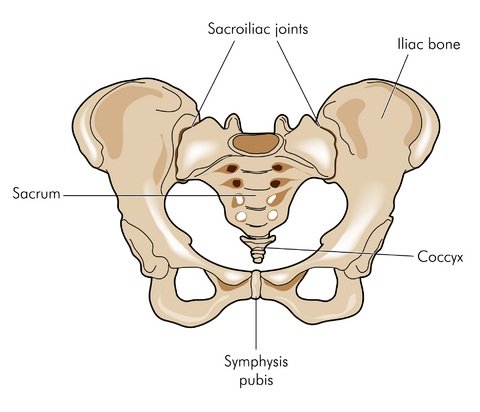The Amazing Female Pelvis
Designed for Giving Birth
The female pelvis is the bony cradle that holds and even rocks your baby while she is developing in the uterus. The word 'pelvis' comes from Latin and means 'basin'.
It is amazingly designed for its functions, especially for giving birth.
The pelvis is well-designed to carry the weight of both the mother and baby. It connects the vertebrae and the lower limbs and protects the reproductive organs, the bladder, intestines and rectum. It also provides attachment for the abdominal muscles and the muscles of the pelvic floor.
The pelvis is made up of four bones: the two large hip bones that form the sides of the cradle and meet at the front and the sacrum and coccyx at the back.

The Female Pelvis and its Design for Labor
The four bones of the pelvis are joined by ligaments that soften and stretch during birth allowing the pelvic outlet to widen and enable the baby to pass through.
The symphosis pubis is the joint at the front between the two hip bones. They are joined with a pad of cartilage.
During pregnancy hormones cause the ligaments soften and stretch causing a slight separation of the joints, which allows flexibility for the baby's head to pass through during birth. Sometimes pregnant women may experience some pelvic pain and discomfort as a result of this loosening of the joints.
At the back of the bony cradle are the sacrum and the coccyx.
The sacro iliac joints, where the strongest ligaments in the body are situated, are often quite strained during the last part of pregnancy and this may cause lower back ache.
Built for Comfort
The pelvis is surrounded by soft tissue that pads the cradle like a well-feathered little nest for baby.
These soft tissues also help with the rotation of the baby's head as it descends through the pubic outlet during the birth.
Before labor begins, the baby's head will rest in the pelvic inlet or brim. This is known as 'engagement'. In the case of a first pregnancy this usually happens at about 38 weeks.
How to Maximize the Pelvic Outlet for Giving Birth
Research has shown that frequent squatting or sitting astride on a chair or stool will enable the pelvic bones to open to maximum. It is a good idea to practice this often during the final weeks of your pregnancy as well as to use upright or squatting positions during labor and birth.
Remain as upright as possible and use gravity to its maximum. When you are lying on your back you actually have to push your baby uphill to get her out!
A supported squat, sitting on a low stool, astride a chair or on a birth ball will enable the baby to move down the birth canal unhindered. Read about 20 benefits of using a birth ball in labor for a faster, easier birth.
Leaning forward on all fours also maximizes the opening of the pelvis.
By AVOIDING lying on your back and birthing in an UPRIGHT POSITION your sacrum will be free to move back and increase the opening in the pelvis by up to 28%, making it much easier for your baby to move through it!
The female pelvis is designed for birthing!
More Pages Related to the Female Pelvis
Big Baby Birth Story - vaginal birth of a 16 pound baby
VBAC - Vaginal Birth After Cesarean
Tips to Avoid Episiotomy and Tearing
Disclaimer: All information is provided for informational purposes only, although every effort is made to provide accurate and current information.
The site content is not intended to be or to substitute for medical advice, diagnosis, or treatment.
Always seek the advice of a suitably qualified health care professional regarding your individual medical needs.
Pregnancy and Giving Birth.com is not responsible nor liable for any advice, course of treatment, diagnosis, services or products obtained via this website.
Return to Top of the Female Pelvis
All Rights Reserved.

